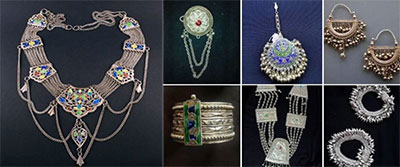
Pahari women are usually bedecked with an assortment of heavy silver ornaments made of sheet metal and wire manipulations which is often reflective of the wearer’s occupation, marital status and community of origin. The head, ears and forehead are the primary focus of jewellery, leading to a plethora of variations. The chiri tikka, sirka chamkuli, daman, or daoni tilak and chakare flat pieces of silver that are worn suspended on the crown , secured with chains that hang along the hairline on both sides. The nose ornaments nath or balu and the septum ornaments bulak or kundu that are worn exclusively by married women are usually highly intricate. Neck ornaments range from the torque like sira or hansli to the small pendants or the toke. Some distinct bead necklaces include – kamrakhi mala, dodmala, jau mala, dar mala etc. of these the Chandrasani haar, constructed of five or seven rows of facetted gold beads, is perhaps the most popular. These ornaments also serve as a means of economic investment for rural women.
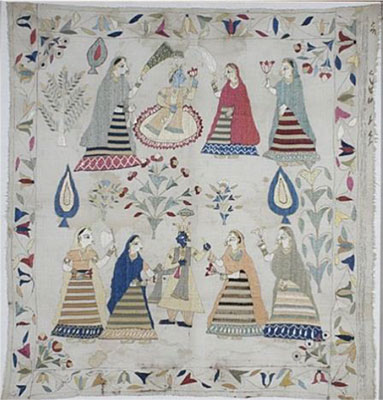
From the 17th century the women of the erstwhile princely state of Chamba (now part of Himachal Pradesh), including members of the royal family, indulged in the embroidery of the rumals or handkerchiefs as a part of marriage gifts to their daughters. Chamba rumals are silk embroidered square pieces of handspun and handwoven unbleached mulmul, used to cover dishes, gifts, offerings, or exchanged between families. The embroidery was done in a double satin stitch technique known as dorukha, developed by upper-class women and has become exclusively related to the craft. Both folk and court styles typically depict popular themes such as Raaslila, Raasmandal, Ashtanayika, hunts, and chaupad and also derived compositions, border motifs, and floral ornamentation from wall paintings of the Rang Mahal of Chamba and the Pahari miniature tradition. In recent years, artisans have been encouraged to reproduce earlier masterpieces and diversify craft products to include a wider range of items such as caps, fans, bedspreads, etc.
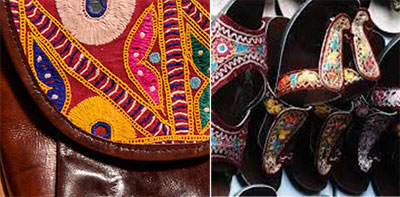
According to a local myth, leather shoes were introduced to the grass-shoe-wearing Chamba Valley by a Kangra princess who married into the royal family of Chamba and brought along a cobbler family. Even to this day, families of cobblers make this now famous chappal, slippers, of embroidered leather. The chappal is made from sheep or goat leather, while women embroider elaborate felt uppers. Chamba kadhai is a chain stitch embroidery technique used to create stylised lantana flowers and leaves, typically embroidered with resham silk threads and russi-tilla synthetic zari threads for a more intricate look. The colour palette typically includes pink, deep green, red, sky blue, and yellow, set against a black or maroon background.

References to the Tibetan art of wood carving date back to the construction of the Tsulhakhang Temple at Lhasa in the 7th century AD. The site is recorded to have contained elaborately carved narrations of the story of the Boddhisattvas as well as Intricately detailed wooden tea bowls, carved windows, shrines and thrones. The wood that is usually used are the khair, chilpine, and other softwoods based on their durability and ease of carving. A traditional bamboo fret saw, known as the bah, is used to create intricate fretwork. The finer details are later carved out using fine chisels and the object is then finished through painting, lacquering, or varnishing. Tibetan artisans brought with them centuries-old woodworking techniques and traditions, which they have continued to practice and preserve in Dharamshala. The intricate designs and craftsmanship of Tibetan woodwork reflect the spiritual and artistic traditions of Tibetan culture, with motifs inspired by Buddhist symbols and nature.
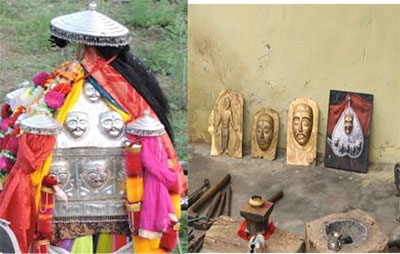
The sheet metal work practiced in Kullu caters largely to the ceremonial requirements of the region’s temples. The chief products are the mohras, the sheet masks depicting the various divinities worshipped locally; chattris, the umbrellas used to shield the deities when they are taken out of the temple in festive processions. The craft also receives an impetus during the nine days of the Dussehra festival when a temporary market is set up and smaller sheet metal objects such as the brass and silver utensils used in domestic rituals and several musical instruments are purchased by devotees. This craft is created from metal sheets on which the form is first transferred and then die-pressed or only beaten. Once the desired shape is achieved, the object is heated in a coal-fired kiln to soften it and grant it luster. Lastly, figurative details are carved and the artefact is polished with lemon leaves.
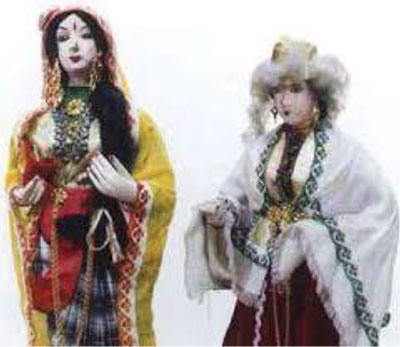
A doll center at Shimla is renowned for its production of a variety of traditionally attired dolls depicting different Pahari communities. The dolls are made from a metal wire skeleton filled with locally procured grass, ensuring dampness to retain its shape. The grass body is then clothed in miniature garments of blended fabric, and a paper-mâché face and a wooden base are affixed onto the doll.
The Kullu doll's attire comprises of a pattu, mid-calf length chequered dress, worn like a short sari over a pair of pajamas. She wears a head scarf called dhatu and carries a cane basket called keelto as a reference to the tea plantations of the district. The Pangi or wedding dolls are known as the gaddan, groom, and gaddi, bride. The bride may be recognized by the flowing veil and joiji, the small-cap, perched jauntily on her head.

Leather shoes were considered inappropriate to be worn on the soil of Himachal Pradesh regarded as the land of gods consequently the sacred grass of shale was used to make the traditional footwear of the paharis, the pula chappal. These lightweight shoes and slippers are worn during religious ceremonies, within temple precincts and to walk on snow. Buckwheat stem is transformed into rope-like forms, strengthened through twisting and stretching. Five loops are formed and tightened around a T-shaped tool. The chappal body is made by intertwining fine grass threads spun on a spindle. Decorative shoe uppers are sometimes created with blanket stitches and contrasting wool colors. A simple system of hand measures is used to make different sizes. Today, although the craft is chiefly practiced in Chad (a village near Banjar), the market for the pula chappal has spread to Rajasthan, Gujarat, and Madhya Pradesh.
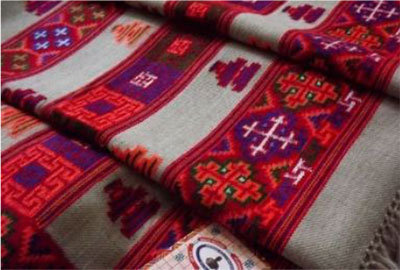
The high-altitude climate of Himachal Pradesh, wool from locally reared sheep and goat, and the ease of procuring high-quality pashmina wool from Tibet have made weaving and spinning important domestic industries, which have now found larger commercial markets outside the state. Merino wool imported from Ludhiana is used to make commercially produced famous Kullu shawls- the twill woven body in the grey, off-white, fawn, or brown shades of natural wool and the tapestry woven borders in multicoloured geometrical forms. Shawls worn by women are called pattu and those worn by men are called chandru. The Kinnaur style where the technique of twill-weaving first developed has largely replaced the chequered shawls that were previously made in Kullu.
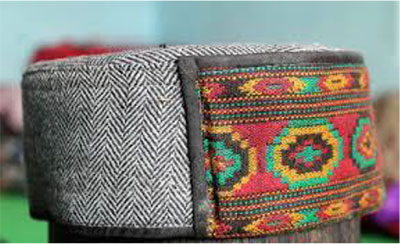
Kullu caps are also a famous part of this industry. It is a traditional headgear considered to be an essential part of the Pahari attire. Colourful Kullu caps are made of pure wool with designs varying from region to region. The cap is round and flat on the top, and the front part of the cap is decorated with a beautifully patterned band woven separately on small looms with colourful borders. The backside, covering the head, is made of local woolen yarn or occasionally cotton or other light materials.
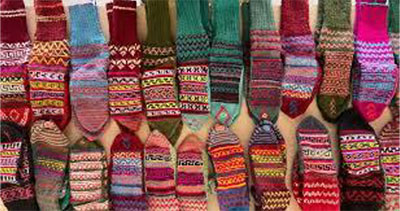
Long hand-knitted socks made with natural sheep wool contrasted with patterns in bright acrylic yarns or black and white are made by women in villages throughout the districts of Kullu, Lahaul, and Spiti. Hand knitting is a technique of fabric construction in which interlinked loops are made from a continuous yarn. These tubular socks are knitted using four needles instead of two. The prevalence of these socks in this region is largely due to the high-altitude climate, the availability of local wool, and the low budgets required for the purchase of basic tools and materials. The coloured stripes and geometric patterns incorporated to enhance the natural shade of wool resemble the border styles of the Kullu shawls and caps.